Smith and Wesson Model 686
by David Hume
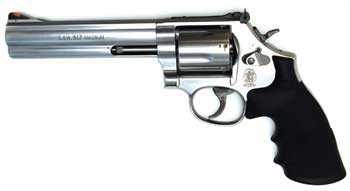 The Smith and Wesson Model 686 has long been a favourite with Australian shooters. The reputation it has earned for reliability, accuracy and versatility means there are many sporting shooters who have one in their safe. The Model 686 is manufactured in three different barrel lengths, 6.4cm (2½"), 10.2cm (4") and 15.2cm (6").
The Smith and Wesson Model 686 has long been a favourite with Australian shooters. The reputation it has earned for reliability, accuracy and versatility means there are many sporting shooters who have one in their safe. The Model 686 is manufactured in three different barrel lengths, 6.4cm (2½"), 10.2cm (4") and 15.2cm (6").
On review was the current Model 686 .357 Magnum, in stainless steel, with the 6" barrel, which is acceptable under the new Australian handgun regulations. Smith and Wesson refers to its calibre as .357/.38, indicating that it may be used with either .357 Magnum or .38 Special ammunition.
It has been suggested that problems may arise shooting .38 Special in a .357 Magnum chamber - slight erosion of the chamber may occur at a point that could cause problems when the slightly longer .357 Magnum cartridge is reintroduced. This would not be an issue with shooters firing target loads, but it does highlight the need for thorough cleaning.
In changing from .38 Special back to .357 Magnum the chamber should be clean, as a build-up of lead might hinder the passage of the longer .357 Magnum cartridge in the chamber. Regular attention with a bronze brush and solvent is a must.
The revolver came supplied in a plastic carry case with the owner’s manual that is common to all Smith and Wesson modern-style revolvers and an external trigger lock.
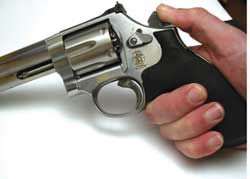
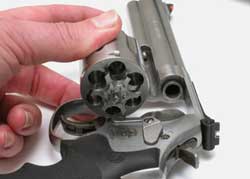
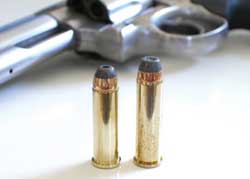
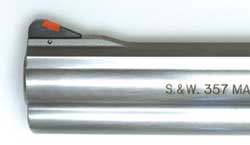 First impression of the revolver is of its weight - this medium-framed
revolver is quite a handful at just more than 1.2kg, and 30cm in
overall length. The next impression is of the quality; the satin finish
of the stainless steel is very fine and all machined surfaces fit to
satisfyingly close tolerances. Pressing the thumb-piece forward allows
the cylinder to swing open to the left, revealing the six chambers.
Smith and Wesson also manufacture a 686 Plus model that holds seven
cartridges rather than the usual six.
First impression of the revolver is of its weight - this medium-framed
revolver is quite a handful at just more than 1.2kg, and 30cm in
overall length. The next impression is of the quality; the satin finish
of the stainless steel is very fine and all machined surfaces fit to
satisfyingly close tolerances. Pressing the thumb-piece forward allows
the cylinder to swing open to the left, revealing the six chambers.
Smith and Wesson also manufacture a 686 Plus model that holds seven
cartridges rather than the usual six.
An interesting feature of this revolver is an internal locking mechanism that is engaged and disengaged by means of an external key. The thumb-piece must be in its forward position to allow the key to be inserted. A quarter-turn of the key will engage the lock and raise a small flag next to the trigger. With the lock engaged the hammer and trigger cannot be moved, but the cylinder may be opened and closed. This is not a safety catch; the lock is intended to be engaged on an empty revolver to prevent its unauthorised use. It is clearly more for the benefit of our American cousins, who may perhaps not have their handguns locked in a safe. It is, however, inconspicuous, and need not affect the use of the revolver by Australian shooters.
The hammer itself is deeply chequered, and provides a very positive grip for the thumb while cocking. Pulling the hammer back causes the cylinder to rotate anticlockwise and the trigger to move back, until a nice positive ‘click’ is both heard and felt, indicating that the revolver is cocked for single-action fire.
The grips supplied are Hogue Rubber; they yield slightly to the touch - without being too soft - and are robust. There is a plastic substructure moulded into the rubber, which fits into the frame and gives structural support to the outer material. The surface is covered with small raised bumps, which provides good texture for a comfortable and secure hold with bare hands. The balance-point of the revolver is just fore of the trigger and even with the long barrel it feels only slightly front-heavy. The substantial mass of the frame is clearly a help in this regard, as is the revolver’s overall length of 30cm.
The sights are very good, aided by a sight radius that is a full 20cm. The front sight is described as ‘red ramp’; this is a black metal ramp into which is inserted a piece of red plastic. It is simple but very effective in providing a clearly defined and highly visible point for aiming. The rear sight is adjustable for windage and elevation, as would be expected, but it also has a white outline added to the black metal. This works particularly well with the red of the front sight to give a very clear and precise picture for dark targets or lowlight situations.
I took the 686 to the range with some handloads and factory rounds; some Fiocchi .38 Special 148-gr SJHP, and some Winchester .357 Magnum 110-gr JHP.
Shooting the .38 Special in single-action mode was very satisfying. The trigger released very cleanly and helped - along with the nice sight picture and good radius - to yield a 12-shot group of two inches at ten yards offhand. Initial impressions in double-action mode were that even though the action was very heavy it had a positive and predictable release. Lightening the action is a simple matter of removing the grip and adjusting the tension on the main spring by means of the strain screw; once this was done it was easier to get consistency in double-action mode. Reducing the spring pressure also reduces the force with which the hammer strikes the cartridge primer and too little tension can result in some rounds not firing - particularly with the hard primers of factory rounds.
Competition shooters will doubtless experiment with different tensions and primers and find the best balance between lightness of action and reliability. After shooting some rounds of .38 Special, moving on to the .357 Magnum rounds was a bit harsh; the recoil was by no means overwhelming, but neither was the experience particularly pleasant. It does, however, highlight the versatility of this revolver, as rounds with a high power factor can be built-up as desired for ISPC events and milder loads used elsewhere.
To sum up - the Model 686 is a competitive out-of-the-box for Service Revolver, Action Revolver, Centrefire and ISPC events. Its accuracy and reliability have during the years made it a popular choice with Australian sporting shooters and the current incarnation of the model invites this popularity to continue.
